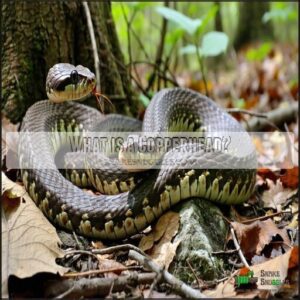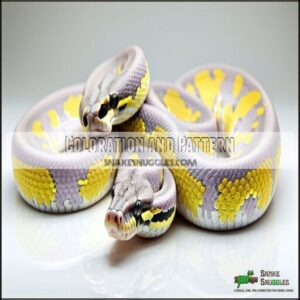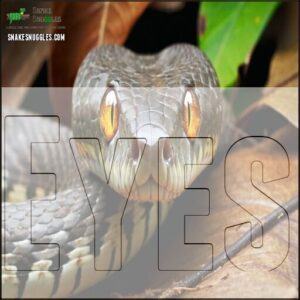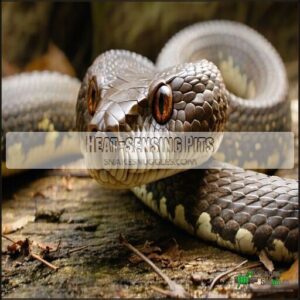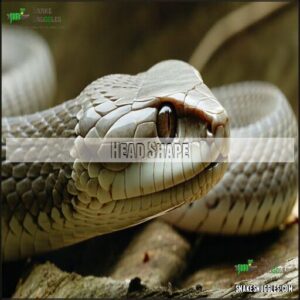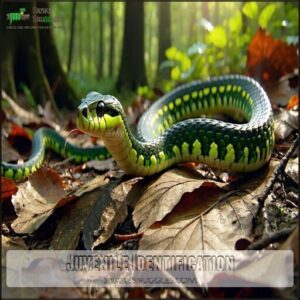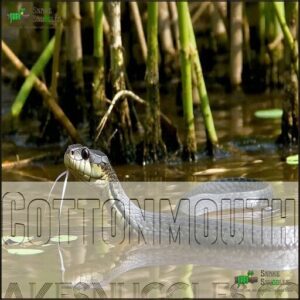This site is supported by our readers. We may earn a commission, at no cost to you, if you purchase through links.
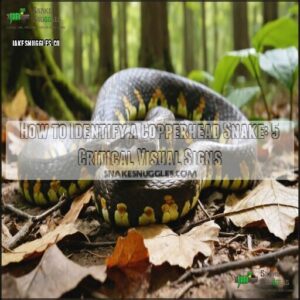 Want to know how to identify a copperhead snake? Look for its signature Hershey’s Kiss-shaped bands—dark brown against a copper or tan background.
Want to know how to identify a copperhead snake? Look for its signature Hershey’s Kiss-shaped bands—dark brown against a copper or tan background.
These venomous serpents sport a distinctive triangular head with heat-sensing pits between their eyes and nostrils. Their pattern’s widest points hug the sides, while the narrowest part crosses the spine.
Copperheads blend masterfully with forest floors, so you’ll need a keen eye. They’re typically 2-3 feet long with thick bodies and a camouflage that screams "don’t mess with me."
Remember, if you’re close enough to see these details, you’re probably too close for comfort. Stay alert and give these guys some space.
Table Of Contents
- Key Takeaways
- What is a Copperhead?
- How to Identify a Copperhead: The 5-Step Guide
- How Rare is a Copperhead Snake?
- Similar Species of Snake
- Frequently Asked Questions (FAQs)
- How do you know if a snake is a Copperhead?
- How to properly identify a Copperhead snake?
- Is a baby Copperhead a snake?
- What if I see a Copperhead?
- How Venomous is a Copperhead Snake?
- What is the Average Lifespan of a Copperhead Snake?
- Are Copperheads Aggressive Towards Humans?
- Do Copperhead Snakes Make Good Pets?
- Can Copperhead Snakes Be Found in Urban Areas?
- How can you tell if a snake is a copperhead?
- Conclusion
Key Takeaways
- You’ll spot a copperhead by its distinctive "Hershey’s Kiss" shaped bands that widen along the snake’s sides and narrow near the spine, creating a unique hourglass pattern against a copper or tan background.
- Look for a triangular head with heat-sensing pits between the eyes and nostrils, and cat-like vertical pupils that distinguish these venomous pit vipers from non-venomous look-alikes.
- Young copperheads have a telltale neon yellow-green tail tip that helps them blend into forest floors, making juvenile identification just as important as recognizing adult snakes.
- Keep a safe distance if you encounter a copperhead, as they’re more interested in avoiding confrontation than attacking, using their incredible camouflage as their primary defense mechanism.
What is a Copperhead?
In the shadowy depths of Eastern and Southeastern forests, the copperhead snake makes its stealthy home.
Stealthy hunters of Eastern forests, copperheads blend silently into nature’s intricate woodland tapestry.
These pit vipers are masters of camouflage, blending perfectly with fallen leaves and rocky terrain.
With a keen eye for small prey like mice and rats, copperheads strategically choose habitats that promise easy hunting.
Silent hunters lurking amid fallen leaves, copperheads strike with calculated precision where prey least expects.
Their venomous reputation might sound scary, but these snakes are actually more reserved than you’d expect.
Living 10-15 years in the wild, they play a vital role in nature’s delicate ecosystem.
While their bite can be dangerous, copperheads prefer to avoid confrontation, using their incredible camouflage as their primary defense mechanism.
Nature’s silent guardians, they move through their environment with remarkable adaptability.
Copperheads exhibit unique copperhead species characteristics that aid in their survival.
How to Identify a Copperhead: The 5-Step Guide
Spotting a copperhead snake can be tricky, but with the right knowledge, you’ll become a pro at identification.
Let’s walk through five critical visual signs that’ll help you recognize these venomous serpents before they catch you off guard.
Coloration and Pattern
Nestled among autumn leaves, copperhead snakes master camouflage with their distinctive coloration. Their body showcases a mesmerizing pattern that helps them disappear into woodland landscapes.
- Background color ranges from copper to tan
- Dark brown "Hershey’s Kiss" shaped bands cross their body
- Bands widen along sides, narrowing near the spine
Their belly tells another story – a cream-colored canvas decorated with bold black checkerboard markings. These dorsal scales and unique hourglass crossbands make copperhead snake identification a true art.
Whether blending with forest floors or rocky terrain, their body color and scale patterns work together as nature’s perfect disguise. Understanding the copperhead snake characteristics is essential for accurate identification.
Eyes
If the hourglass-patterned body of a copperhead doesn’t catch your eye, its striking cat-like gaze certainly will.
In the context of copperhead snake identification, those vertical pupils are a dead giveaway. Unlike harmless snakes with round eyes, these venomous predators sport elliptical pupils that slice through daylight like nature’s own razor blades.
Key eye characteristics include:
- Golden or amber iris patterns that gleam with predatory intensity
- Vertical pupils that narrow dramatically, reminiscent of a feline’s sharp focus
- A protective ridge above each eye, giving the snake a hooded, almost prehistoric look
These eye features aren’t just for show – they’re survival tools that make copperhead snake identification a matter of keen observation and respectful distance. Studying snake eye patterns can help enthusiasts better understand these unique characteristics.
Heat-sensing Pits
Almost like a thermal imaging device, a copperhead’s heat-sensing pits are nature’s most precise infrared detectors.
These special sensory organs sit strategically between the snake’s eyes and nostrils, acting as advanced temperature sensors.
Pit vipers can detect temperature differences as tiny as 0.003 degrees Celsius, allowing them to track warm-blooded prey with incredible accuracy.
This remarkable pit structure transforms the copperhead’s hunting strategy, enabling it to "see" heat signatures that are invisible to the human eye, making these sensory organs a critical component of the snake’s survival toolkit.
The ability to detect heat is made possible by complex infrared detection systems, which is a key factor in the snake’s ability to thrive.
Head Shape
After detecting those heat-sensing pits, your next clue in copperhead snake identification is their unmistakable head shape. Think of a snake head that looks like a perfect spade from a deck of cards – wide at the base and tapering to a rounded point.
Key copperhead head characteristics include:
- A distinctly triangular skull structure wider than the neck
- Smooth scale patterns flowing seamlessly across the facial region
- A permanent "worried" look from ridged scales above the eyes
Pit vipers like copperheads have heads that scream "venomous" through their geometry. While some non-venomous snakes can flatten their heads when threatened, the copperhead’s triangular profile remains a reliable marker. This unique head structure is nature’s built-in warning sign, helping you spot these fascinating creatures from a safe distance.
Juvenile Identification
Continuing from the triangular head, juvenile copperheads reveal nature’s clever camouflage trick.
With a neon yellow-green tail tip, these mini-vipers blend seamlessly into forest floors.
Born 7-10 inches long, they mimic adult copperhead snake identification features – same spear-shaped head, distinctive Hershey’s Kiss bands, and heat-sensing pits.
Their body pattern screams "copperhead" from day one, making juvenile copperhead recognition key for outdoor safety.
| Feature | Description | Importance |
|---|---|---|
| Tail Tip | Neon yellow-green | Prey attraction |
| Body Pattern | Hourglass bands | Camouflage |
| Head Shape | Triangular | Venom identification |
| Size | 7-10 inches | Early recognition |
| Habitat | Forest edges | Natural environment |
How Rare is a Copperhead Snake?
Regarding copperhead snakes, these venomous reptiles are far from rare. They’re widespread across the eastern and central United States, thriving in diverse landscapes.
- Adaptable predators conquering suburban gardens and dense forests
- Mild venom that helps them avoid aggressive human encounters
- Stable populations thanks to abundant prey like mice and insects
Copperheads prefer stealth over confrontation, making most encounters accidental. Their remarkable camouflage and cautious nature mean they’d rather slip away unnoticed than engage in a standoff.
Understanding their distribution helps you stay alert and respectful in their territories.
Similar Species of Snake
When you’re out in nature, it’s vital to know that several snake species look remarkably similar to copperheads, which can make identification tricky for untrained eyes.
Learning to distinguish these look-alikes from the venomous copperhead could save you from a potentially dangerous encounter.
Brown or Banded Watersnake
Mistaking a brown or banded watersnake for a copperhead could turn your nature walk into a nerve-wracking adventure.
These lookalikes might share similar patterns, but they’re worlds apart in danger level.
| Feature | Watersnake | Copperhead |
|---|---|---|
| Head Shape | Rounded | Triangular |
| Pupils | Round | Cat-like |
| Venom Pits | Absent | Present |
| Body Pattern | Square marks | Hourglass bands |
| Habitat | Freshwater | Forested areas |
Unlike their venomous cousins, watersnakes lack heat-sensing pits and boast harmless, rounded heads – key details in your snake identification guide.
Understanding a snake identification process is important for accurate species recognition, and recognizing the difference between a watersnake and a copperhead can be crucial.
Cottonmouth
While watersnakes blend into brown landscapes, cottonmouths command attention with their dramatic water-loving lifestyle.
Unlike copperheads, these pit vipers prefer marshes and swamps, sporting a more muscular build and darker coloration.
- Watch for their signature white mouth flash when threatened
- Spot the distinctive eye-stripe marking
- Note their preference for aquatic environments
Cottonmouths aren’t just another snake – they’re nature’s swimming tanks. Thicker, darker, and more aggressive than their woodland cousins, they demand respect in their watery domains. Your best move? Admire from a safe distance.
Understanding their venom composition is essential for appreciating these creatures. Cottonmouths have a unique lifestyle that sets them apart, with their dramatic water-loving lifestyle and muscular build making them a fascinating subject. They are more aggressive than other snakes, which is an important factor to consider when encountering them.
Frequently Asked Questions (FAQs)
How do you know if a snake is a Copperhead?
You’ll spot a Copperhead by its triangular head, cat-like pupils, and distinctive hourglass-shaped bands.
Watch for copper-colored skin and heat-sensing pits between its eyes and nostrils.
Stay alert, but don’t panic if you see one, and remember to be cautious of its copper-colored skin.
How to properly identify a Copperhead snake?
Look for a venomous snake with a triangular head, cat-like eyes, and copper-colored bands.
Check for heat-sensing pits between the eyes and nostrils.
If unsure, keep your distance and call a professional.
Is a baby Copperhead a snake?
Yes, a baby Copperhead is absolutely a snake.
These tiny serpents pack a venomous punch with their triangular heads and heat-sensing pits, mirroring their parents’ distinctive hourglass-patterned bodies and copper-colored features.
What if I see a Copperhead?
With 5,000 snake bites annually, stay calm if you encounter a copperhead.
Back away slowly, don’t panic. Maintain a safe distance, avoid sudden movements, and seek professional help if you’re too close for comfort.
How Venomous is a Copperhead Snake?
Copperhead venom packs a serious punch, causing intense pain and potential tissue damage.
While rarely fatal, their bite demands immediate medical attention.
Stay calm, seek help quickly, and avoid provoking these defensive pit vipers to minimize the risk of tissue damage.
What is the Average Lifespan of a Copperhead Snake?
You’ll typically see these venomous serpents living 10 to 15 years in the wild, with some individuals potentially reaching up to 18 years if they dodge predators and find consistent food sources in their natural habitat.
Are Copperheads Aggressive Towards Humans?
Freeze, panic, react—that’s your instinct.
But copperheads aren’t hunting you. They’re shy, preferring camouflage over confrontation.
You’ll likely startle them more than they’ll threaten you, so stay calm and give them space.
Do Copperhead Snakes Make Good Pets?
You’ll want to steer clear of these venomous reptiles as pets.
Their dangerous bite, specialized care needs, and legal restrictions make copperheads terrible companions.
Stick to safer, more domesticated snake species if you’re craving a scaly friend. Their dangerous bite, specialized care needs, and legal restrictions make copperheads terrible companions.
Can Copperhead Snakes Be Found in Urban Areas?
When urban landscapes sprawl into wild territories, you’ll find copperheads slithering near construction sites, parks, and wooded neighborhoods.
They’re adaptable hunters seeking shelter in bushes, stone walls, and abandoned spaces where mice scurry.
How can you tell if a snake is a copperhead?
Look for a venomous snake with a triangular head, cat-like pupils, and distinctive hourglass-shaped bands.
Check for heat-sensing pits between eyes and nostrils.
When in doubt, keep your distance and call a professional.
Conclusion
Slithering through nature’s canvas, copperheads remind us that beauty and danger often intertwine.
When you’re learning how to identify a copperhead snake, trust your instincts and keen observation. Stay alert, respect their space, and remember: knowledge is your best defense.
Whether hiking or exploring wooded areas, understanding these serpents’ unique characteristics can keep you safe. Knowledge empowers, so keep learning and stay cautious in snake territory, always remembering to stay alert.

